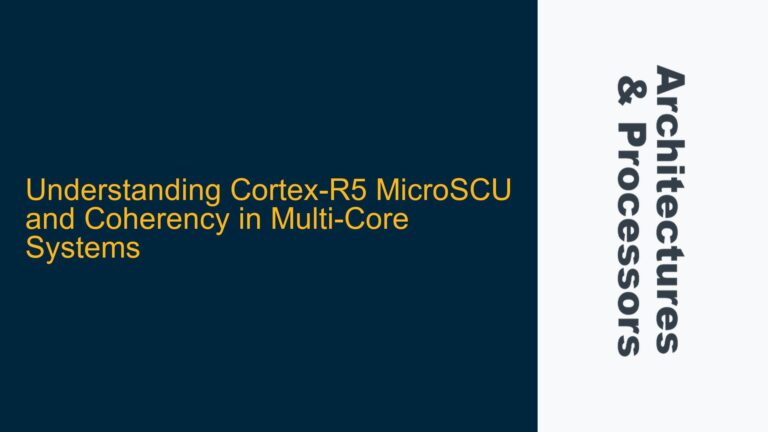Understanding TTBR1_EL1 Alignment Requirements for 4KB Granule Translation Tables
The alignment constraints for the Translation Table Base Register 1 (TTBR1_EL1) in ARMv8 architectures are a critical aspect of memory management, particularly when configuring translation tables for virtual memory. The alignment requirements are influenced by the translation granule size, the size of the virtual address space, and the specific configuration of the translation tables. For a 4KB granule size, the alignment constraints are derived from the number of entries in the first-level translation table and the size of the virtual address space being mapped.
The key to understanding these constraints lies in the relationship between the translation table base address, the number of entries in the first-level table, and the alignment requirements specified in the ARM Architecture Reference Manual (ARM ARM). Specifically, the alignment of the translation table base address is determined by the number of entries in the first-level table, which in turn depends on the size of the virtual address space being mapped. For example, when mapping a 4 GiB virtual address space with a 4KB granule size, the first-level table will have 4 entries, requiring a 16KB alignment. Similarly, for a 16 GiB virtual address space, the first-level table will have 16 entries, requiring a 64KB alignment.
The confusion often arises from the interpretation of the alignment requirements specified in the ARM ARM. The manual states that the translation table must be aligned to the size of the table, but it also provides a formula for calculating the alignment based on the number of entries in the first-level table. This formula is derived from the relationship between the size of the virtual address space, the number of entries in the first-level table, and the alignment requirements. For a 4KB granule size, the alignment is calculated as follows: the number of entries in the first-level table is equal to 2^(x), where x is the number of bits required to represent the size of the virtual address space. The alignment is then determined by the number of entries in the first-level table, with each entry requiring a 4KB alignment.
Misinterpretation of ARM ARM Documentation and Conflicting Alignment Calculations
One of the primary sources of confusion in configuring TTBR1_EL1 alignment is the potential misinterpretation of the ARM Architecture Reference Manual (ARM ARM) documentation. The manual provides detailed information on the alignment requirements for translation tables, but the relationship between the size of the virtual address space, the number of entries in the first-level table, and the alignment requirements can be complex and difficult to parse. Specifically, the manual states that the translation table must be aligned to the size of the table, but it also provides a formula for calculating the alignment based on the number of entries in the first-level table. This formula is derived from the relationship between the size of the virtual address space, the number of entries in the first-level table, and the alignment requirements.
The confusion often arises from the interpretation of the alignment requirements specified in the ARM ARM. The manual states that the translation table must be aligned to the size of the table, but it also provides a formula for calculating the alignment based on the number of entries in the first-level table. This formula is derived from the relationship between the size of the virtual address space, the number of entries in the first-level table, and the alignment requirements. For a 4KB granule size, the alignment is calculated as follows: the number of entries in the first-level table is equal to 2^(x), where x is the number of bits required to represent the size of the virtual address space. The alignment is then determined by the number of entries in the first-level table, with each entry requiring a 4KB alignment.
The conflicting interpretations of the alignment requirements can lead to incorrect configuration of the TTBR1_EL1 register, resulting in memory management faults and other system instability issues. For example, if the alignment is calculated based on the size of the virtual address space without considering the number of entries in the first-level table, the resulting alignment may be insufficient, leading to misaligned translation tables and potential memory access violations. Conversely, if the alignment is calculated based on the number of entries in the first-level table without considering the size of the virtual address space, the resulting alignment may be overly conservative, leading to unnecessary memory fragmentation and reduced system performance.
Correctly Configuring TTBR1_EL1 Alignment for 4KB Granule Translation Tables
To correctly configure the alignment of the TTBR1_EL1 register for 4KB granule translation tables, it is essential to follow a systematic approach that takes into account both the size of the virtual address space and the number of entries in the first-level translation table. The first step is to determine the size of the virtual address space being mapped, which will dictate the number of entries required in the first-level table. For example, a 4 GiB virtual address space will require 4 entries in the first-level table, while a 16 GiB virtual address space will require 16 entries.
Once the number of entries in the first-level table has been determined, the alignment requirement can be calculated using the formula provided in the ARM ARM. For a 4KB granule size, the alignment is calculated as follows: the number of entries in the first-level table is equal to 2^(x), where x is the number of bits required to represent the size of the virtual address space. The alignment is then determined by the number of entries in the first-level table, with each entry requiring a 4KB alignment. For example, for a 4 GiB virtual address space, the first-level table will have 4 entries, requiring a 16KB alignment. Similarly, for a 16 GiB virtual address space, the first-level table will have 16 entries, requiring a 64KB alignment.
It is also important to ensure that the translation table base address is correctly aligned in memory. This can be achieved by using memory allocation functions that guarantee the required alignment, or by manually aligning the base address to the required boundary. Once the translation table base address has been correctly aligned, it can be written to the TTBR1_EL1 register, ensuring that the translation table is correctly configured and that the virtual memory system operates as expected.
In summary, correctly configuring the alignment of the TTBR1_EL1 register for 4KB granule translation tables requires a thorough understanding of the relationship between the size of the virtual address space, the number of entries in the first-level table, and the alignment requirements specified in the ARM ARM. By following a systematic approach and carefully calculating the alignment requirements, it is possible to ensure that the translation table is correctly configured and that the virtual memory system operates reliably and efficiently.






